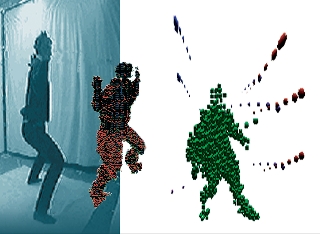Technische Beschreibung
(DIESER TEXT LIEGT NUR IN ENGLISCH VOR) Traces is an installation for the CAVE virtual environment. The CAVE system, developed at the University of Chicago, is a small room, on whose walls are projected three-dimensional images. When the user wears 3-D glasses, he has the illusion that he is surrounded by virtual objects — but in contrast to traditional head-mounted displays, he can still see his body.
For Traces, we have built a vision system for the CAVE, with which we can build a 3-D model of the user’s body. This model is used to generate 3-D traces of the user’s movements, which appear around the user.
At first (Passive Trace), the traces passively follow the movements of the user. They are transparent, and slowly float and fade away. Soon (Active Trace) they begin to build their own structures. They are still generated as traces of movement, but then develop further using a Cellular Automaton algorithm. The traces sparkle; they begin to become lively.
In the third phase (Chinese Dragons), small abstract creatures are thrown off the movements of the user. At first they fly off with the momentum of the movement that created them; then they begin to behave autonomously. They fly through the space, and chase behind the user.
The vision system works using four small video cameras, which perceive the user from the top corners of the CAVE. They work in infrared, so that they are not affected by the CAVE graphics. From these four pictures, a voxel model of the user is built, with voxels of diameter of about 5 cm. The system generates 15 voxel models per second.
The Passive Trace is generated directly from the voxel model. Transparency of the voxels is calculated from their age. The Active Trace is also based on the voxel model, but extends it with a 3-dimensional cellular automaton, that specifies the liveliness, color, and transparency of cells. Cells become alive when they lie within the voxel model, or when they do not have too many or too few neighbours. Although this automaton contains 10,000 cells, it can be calculated in real-time because it is very sparse.
The Chinese Dragons are generated when the heuristically identified hands, feet, or head of the voxel model move quickly. Their movements are driven by a custom-made autonomous agent architecture. Dragons can sense the body of the user through the voxel model and react in real-time to the user’s movements. They use Craig Reynolds’ flocking algorithms in order to fly through the CAVE in a coordinated manner.
Traces is a collaboration of researchers from Carnegie Mellon University (CMU), the GMD, and the Center for Art and Media Technology (ZKM). The vision system was built by Simon Penny (CMU) and Andre’ Bernhard. The computer graphics were developed by Jeffrey Smith (CMU), and the Chinese Dragons by Phoebe Sengers (GMD.MARS). Jamie Schulte (CMU) built a sound system for the traces. Development of Traces at the GMD takes place in the MARS Exploratory Media Lab, with the support of the VMSD group.
Text by Phoebe Sengers


